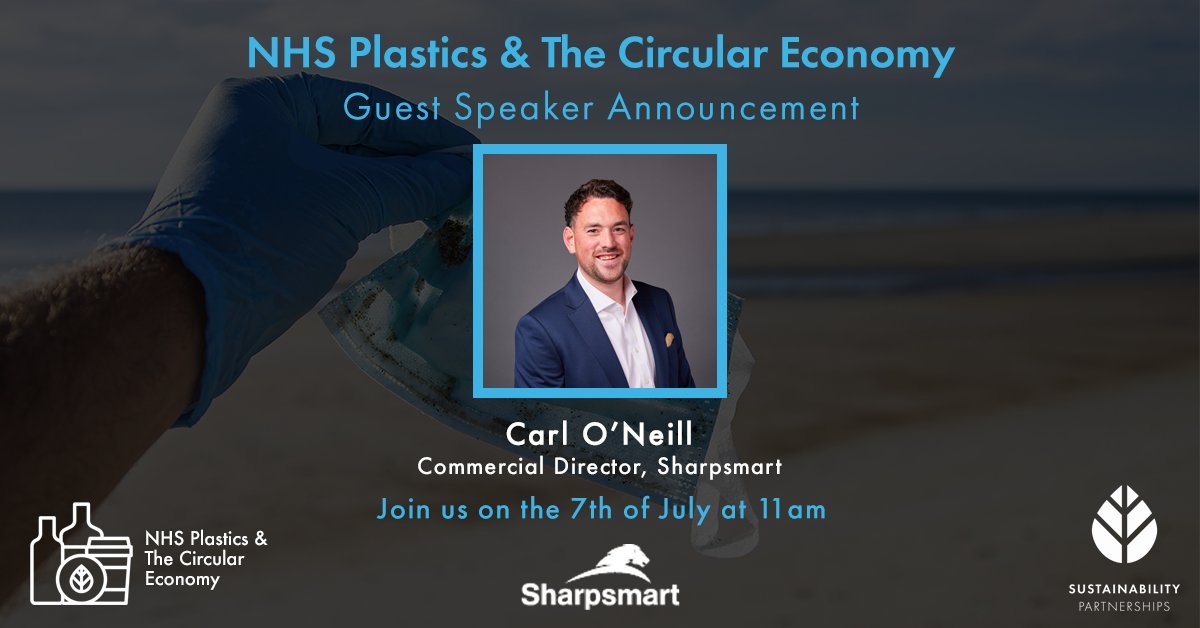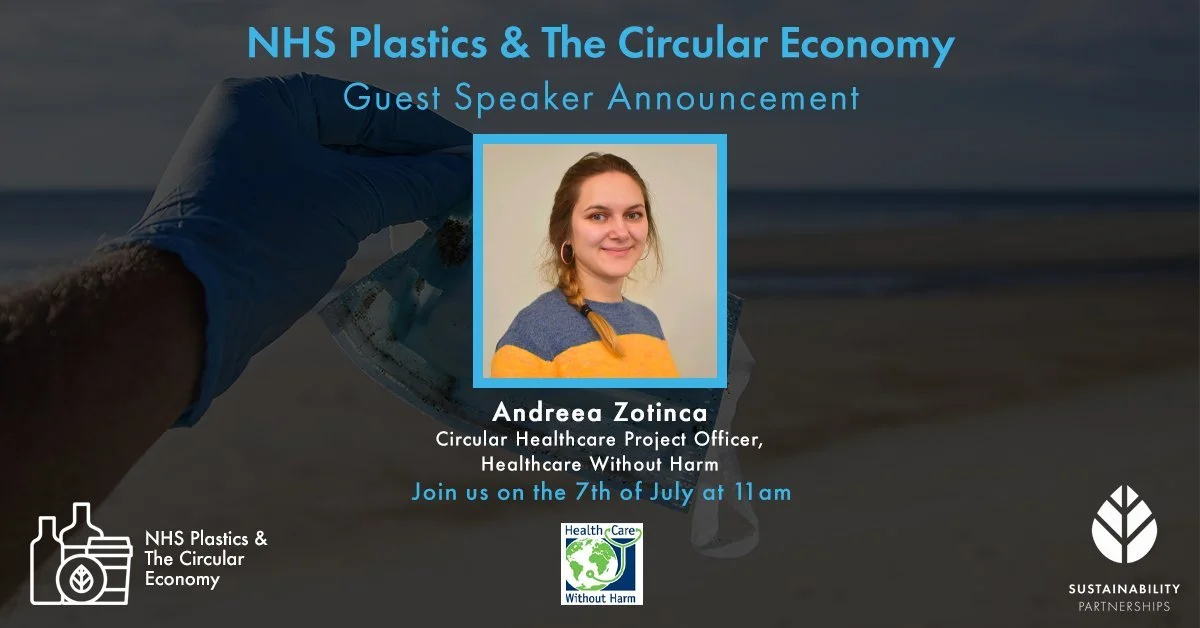NHS Plastics & The Circular Economy
The latest reported WRAP figures found that 3.7 million tonnes of plastic is being thrown away in the UK each year, with only 32% of this being recycled and 30% littered. Plastic historically has been a safe and cheap alternative to glass, paper, or cardboard within many industries, and within our NHS, single-use plastics have been vital in maintaining sterile environments for both patients and NHS professionals. But with the ever-growing threat of our diminishing environment, public awareness of plastic pollution is igniting a want for change.
We are seeing increasing levels of new and innovative products and services being introduced across the NHS to help tackle our plastic problem. From reusable products and recycling systems to choosing plastic products with a lesser carbon footprint, so, our latest webinar invited an expert panel of industry professionals to discuss new products and processes being developed which have the ability to aid the NHS in driving a greener future.
Carl O’Neill, Commercial Director, Sharpsmart
Our first speaker of the day was Carl O’Neill, Commercial Director at Sharpsmart. Carls’s presentation focussed on how Sharpsmart works alongside healthcare professionals to support them in removing plastics where possible and also reducing the effect had during the plastic disposal process. Carl started by talking to the audience through the processes taken by Sharpsmart in their partnerships with organisations.
“To start off with, we work on getting within the four walls of the hospitals to understand what the challenges of the organisation are when it comes to waste management and plastic waste.”
He then went on to explain their most popular product; reusable sharps containers, which completely replace the formerly used disposable containers. This is a huge reduction in waste as, for every 100 beds in the hospital, there are 3.1 tonnes of plastic waste from sharps, which equates to 11.2 tonnes of CO2.
“Our mission is to actually help. We really look into how we can treat waste in the most sustainable way and how we can make sure waste is being placed into the correct containers.”
Carl then moved on to explain the waste disposal methods for sharps, touching on Sharpsmart’s own treatment method which involves sharps being shredded, sterilised and the effluent retained to allow the flock and the output to be good on the SRF route to generate you know, to have a more sustainable method of treatment.
Catch up on Carl’s slides here.
Ole Grøndahl Hansen, Project Manager, PVCMed Alliance
Our second speaker of the day was Ole Grøndahl Hansen, Project Manager at PVCMed Alliance. Ole kicked off his discussion by showcasing a hard-hitting video which showed the amount of waste created from a single medical procedure, which can be seen here. Ole then began his presentation on the use of PVC within healthcare.
“PVC is the most used polymer within medical devices. Almost 30% of medical devices made from plastics are made of PVC and the rest of the share is split between 10 to 12 different other different polymers.”
Ole then spoke to the audience about recent studies that found that PVC is to maintain its leading role in healthcare for years to come, and therefore recycling this should be one of our largest focuses. He explained the reasons why PVC is the material of choice in healthcare, including its safety and flexibility.
Ole then went on to speak further about the importance of recycling and repurposing PVC in healthcare.
Catch up on Ole’s slides here.
“The two main concerns that linked to the use of PVC in healthcare today is the plasticizers. It has mostly been on the safety, the migration of plasticizers into the patient.”
Shannon Stone, Resources and Waste Management Consultant, Mott Macdonald
Next up, we had Shannon Stone, Resources and Waste Management Consultant at Mott Macdonald. Shannon’s presentations talked about how Mott Macdonald supports the NHS in raising awareness of the circular economy. Shannon spoke us through a few of the services offered by Mott Macdonald including lifecycle assessments, supply chain management, design, and manufacturing designed for manufacturing assembly, as well as providing training and education materials to support clients.
“When it comes to healthcare organisations we have been working with NHS and other large organisations such as the Global Fund with supporting them in improving waste management to be more sustainable.”
Shannon then went on to speak about how they aid their clients in building a circular economy into their long-term plans within their businesses, including how they aid people in tackling their plastic usage and waste.
Shannon finished off her presentation with an explanation of the training materials provided at Mott Macdonald to their clients, stating that the training materials and each key principle, provide practical examples that can be used by those procurement managers in how they can initiate change.
“The reason plastic is part of the technical loop is plastics are to be kept at the highest value at all times. And that #recycling is considered to be the last option. There’s a huge emphasis on retaining products for as long as possible.”
Catch up on Shannon’s slides here.
Andreea Zotinca, Circular Healthcare Project Officer, Healthcare Without Harm
Our final speaker of the day Andreea Zotinca, Circular Healthcare Project Officer at Healthcare Without Harm came on to speak about plastic reduction and the waste hierarchy within healthcare. She began her presentation by talking attendees through the meaning behind and use of the waste hierarchy.
“The waste hierarchy is vital to tackling our waste problem. You can see that in the upper part, it’s prevention which is the preferred action that we can take to reduce waste. The impact of plastics isn’t a mystery to anyone anymore and we need to act.”
Andreea then went on to talk about the high importance of focussing on the reduction of plastic use rather than simply looking at recycling as a sole solution.
She explained how we do not have the recycling capacity to deal with our current level of use and that, as plastic quality is reduced over multiple cycles of recycling, virgin plastic is still required. She finished her talk by running through some of the many health risks of plastic use.
Catch up on Andreea’s slides here.
“There are many problematic chemicals in plastics which patients are exposed to. A recent study conducted in Belgium last year stated that newborns in intensive care units are exposed to HP levels that are above the tolerable daily intake.”
This webinar discussed new products and solutions being developed to aid the NHS in tackling their plastic usage and waste disposal. A collaborative approach is needed to truly strive for a greener future within the NHS. If you would like more information or are interested in speaking on one of our future webinars, please do not hesitate to get in contact.




